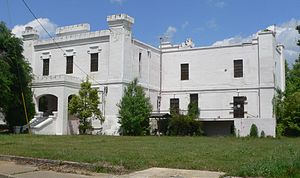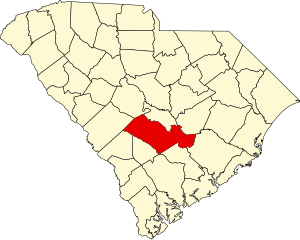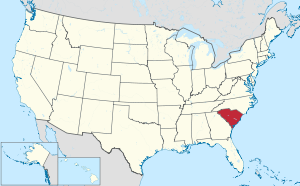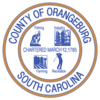Orangeburg County, South Carolina
Orangeburg County | |
|---|---|
 | |
| Motto: "Community & Character" | |
 Location within the U.S. state ofSouth Carolina | |
 South Carolina's location within theU.S. | |
| Coordinates:33°26′N80°48′W/ 33.44°N 80.80°W | |
| Country | |
| State | |
| Founded | March 12, 1785 |
| Named for | William of Orange |
| Seat | Orangeburg |
| Largest community | Orangeburg |
| Area | |
| • Total | 1,127.89 sq mi (2,921.2 km2) |
| • Land | 1,106.38 sq mi (2,865.5 km2) |
| • Water | 21.51 sq mi (55.7 km2) 1.91% |
| Population (2020) | |
| • Total | 84,223 |
| • Estimate (2023) | 82,820 |
| • Density | 76.12/sq mi (29.39/km2) |
| Time zone | UTC−5(Eastern) |
| • Summer (DST) | UTC−4(EDT) |
| Congressional districts | 2nd,6th |
| Website | www |
Orangeburg Countyis acountylocated in theU.S. stateofSouth Carolina.As of the2020 census,the population was 84,223.[1]Itscounty seatisOrangeburg.[2]The county was created in 1769.[3]
Orangeburg County comprises the Orangeburg, South CarolinaMicropolitan Statistical Area,which is also included in theColumbia-Sumter-Orangeburg,South Carolina Combined Statistical Area. It is located in theMidlands of South Carolina.
It is the home ofSouth Carolina State University,the only public four-yearhistorically Black universityin South Carolina. It is also home toClaflin University,the oldesthistorically Black college or university(HBCU) in the state.
History
[edit]The district was occupied for thousands of years byIndigenous peoples of the Southeastern Woodlands.By the time of European arrival,Siouan-speaking tribes, such as theCherawandCatawba,as well as thePee Dee,inhabited thePiedmontarea above thefall line.
The Orangeburg Judicial District was chartered by European Americans in 1769 from a mostly unorganized upland area between theCongareeandSavannahrivers. A county, initially of the same name but later called Orange, was organized within the district but deorganized in 1791, after theAmerican Revolutionary War.
The southwest portion bordering on the Savannah River, about half of Orangeburg District, was separated and organized asBarnwell Districtin 1800. In 1804 the northern third of the district was separated to form the newLexington District,which gained another, smaller portion of Orangeburg District in 1832.
During the 19th century, the districts and counties were developed chiefly as cottonplantationsfor short-staple cotton. This development followed the invention of thecotton ginin the late 18th century, which made the processing of short-staple cotton profitable. The county became a center of labor by enslaved Black people on the plantations, who were transported from coastal areas and the Upper South to cultivate and process cotton. Those brought from the coastal areas were likely of theGullahculture and language. The enslaved African Americans greatly outnumbered the white planters and non-slaveholding whites. Reflecting the patterns of 19th-century settlement, the area is still chiefly agricultural and has a majority African American population.
In 1868, under the revised state constitution during theReconstruction era,South Carolina districts were organized as counties. Resident voters were enabled to elect their state representatives rather than having them chosen by the state legislature, as was done previously. Election of representatives by the state legislature had kept the districts dominated by the elite owners of majorplantationsin theLow Countryand elsewhere. The changes in rules expanded participation in the franchise by more male residents. Emancipation of slaves after the war under newly ratified federal constitutional amendments resulted infreedmenvoting. Using voter intimidation, white Democrats took control of the state legislature by the end of the century; they passed state electoral laws and a new constitution that essentiallydisfranchisedmost blacks, a situation that lasted until after the federal legislation of the1965 Voting Rights Act.
A small western portion of Orangeburg County was annexed in 1871 to the newly formedAiken Countyduring the Reconstruction era.
In 1908 the northern portion of the County along the Congaree River was separated and included in the newly formedCalhoun County,with its seat atSaint Matthews.In 1910 a small western portion ofBerkeley County,around Holly Hill and Eutawville, was annexed to Orangeburg County, thus bringing the county to its present size.
Geography
[edit]
According to theU.S. Census Bureau,the county has a total area of 1,127.89 square miles (2,921.2 km2), of which 1,106.38 square miles (2,865.5 km2) is land and 21.51 square miles (55.7 km2) (1.91%) is water.[4]It is the second-largest county in South Carolina by land area and fifth-largest by land area.
Orangeburg county is a fairly big county, covering 1,128 square miles, it is about 60 miles from the western part of the county to the eastern part of the county. Orangeburg county lies within 3 "regions" of South Carolina. The western part of the county lies in the "CSRA" (Central Savannah River Area). The middle part of Orangeburg county is included in the "Midlands" Region. The eastern and south eastern part of the county are located in the "Lowcountry" region of the state.
National protected areas
[edit]State and local protected areas
[edit]Major water bodies
[edit]- Congaree River
- Cooper River
- Edisto River
- Four Hole Swamp
- Lake Marion
- North Fork Edisto River
- South Fork Edisto River
Adjacent counties
[edit]- Calhoun County– north
- Clarendon County– northeast
- Dorchester County– southeast
- Berkeley County– southeast
- Bamberg County– south
- Colleton County– south
- Aiken County– west
- Barnwell County– west
- Lexington County– northwest
Demographics
[edit]| Census | Pop. | Note | %± |
|---|---|---|---|
| 1790 | 18,513 | — | |
| 1800 | 15,766 | −14.8% | |
| 1810 | 13,229 | −16.1% | |
| 1820 | 15,653 | 18.3% | |
| 1830 | 18,453 | 17.9% | |
| 1840 | 18,519 | 0.4% | |
| 1850 | 23,582 | 27.3% | |
| 1860 | 24,896 | 5.6% | |
| 1870 | 16,865 | −32.3% | |
| 1880 | 41,395 | 145.4% | |
| 1890 | 49,393 | 19.3% | |
| 1900 | 59,663 | 20.8% | |
| 1910 | 55,893 | −6.3% | |
| 1920 | 64,907 | 16.1% | |
| 1930 | 63,864 | −1.6% | |
| 1940 | 63,707 | −0.2% | |
| 1950 | 68,726 | 7.9% | |
| 1960 | 68,559 | −0.2% | |
| 1970 | 69,789 | 1.8% | |
| 1980 | 82,276 | 17.9% | |
| 1990 | 84,803 | 3.1% | |
| 2000 | 91,582 | 8.0% | |
| 2010 | 92,501 | 1.0% | |
| 2020 | 84,223 | −8.9% | |
| 2023 (est.) | 82,820 | [1] | −1.7% |
| U.S. Decennial Census[6] 1790–1960[7]1900–1990[8] 1990–2000[9]2010[10]2020[1] | |||
2020 census
[edit]| Race | Num. | Perc. |
|---|---|---|
| White(non-Hispanic) | 27,787 | 32.99% |
| Black or African American(non-Hispanic) | 50,802 | 60.32% |
| Native American | 467 | 0.55% |
| Asian | 892 | 1.06% |
| Pacific Islander | 37 | 0.04% |
| Other/Mixed | 2,271 | 2.7% |
| HispanicorLatino | 1,967 | 2.34% |
As of the2020 census,there were 84,223 people, 32,129 households, and 20,620 families residing in the county.
2010 census
[edit]At the2010 census,there were 92,501 people, 35,788 households, and 23,580 families in the county.[12][10]The population density was 83.6 inhabitants per square mile (32.3 inhabitants/km2). There were 42,504 housing units at an average density of 38.4 units per square mile (14.8 units/km2).[13]Theracial makeupof the county was 62.2% black or African American, 34.3% white, 0.8% Asian, 0.5% American Indian, 0.9% from other races, and 1.2% from two or more races. Those of Hispanic or Latino origin made up 1.9% of the population.[12]In terms of ancestry, 7.7% wereAmerican,and 5.1% wereGerman.[14]
Of the 35,788 households, 32.5% had children under the age of 18 living with them, 38.1% were married couples living together, 22.5% had a female householder with no husband present, 34.1% were non-families, and 29.0% of households were made up of individuals. The average household size was 2.49 and the average family size was 3.06. The median age was 38.1 years.[12]
The median household income was $32,849 and the median family income was $40,332. Males had a median income of $35,934 versus $28,508 for females. The per capita income for the county was $17,579. About 21.1% of families and 25.8% of the population were below thepoverty line,including 32.9% of those under age 18 and 19.1% of those age 65 or over.[15]
2000 census
[edit]At the2000 census,there were 91,582 people, 34,118 households, and 23,882 families in the county. The population density was 83 people per square mile (32 people/km2). There were 39,304 housing units at an average density of 36 units per square mile (14 units/km2). Theracial makeupof the county was 60.86% Black or African American, 37.17% White, 0.46% Native American, 0.43% Asian, 0.02% Pacific Islander, 0.36% from other races, and 0.70% from two or more races. 0.96% of the population were Hispanic or Latino of any race.[16] Of the 34,118 households 32.00% had children under the age of 18 living with them, 45.10% were married couples living together, 20.30% had a female householder with no husband present, and 30.00% were non-families. 26.00% of households were one person and 10.30% were one person aged 65 or older. The average household size was 2.58 and the average family size was 3.11.
The age distribution was 26.00% under the age of 18, 11.90% from 18 to 24, 26.10% from 25 to 44, 22.80% from 45 to 64, and 13.20% 65 or older. The median age was 35 years. For every 100 females there were 87.00 males. For every 100 females age 18 and over, there were 81.60 males.
The median household income was $29,567 and the median family income was $36,165. Males had a median income of $29,331 versus $20,956 for females. The per capita income for the county was $15,057. About 17.00% of families and 21.40% of the population were below thepoverty line,including 27.20% of those under age 18 and 22.30% of those age 65 or over.
State-recognized tribes
[edit]Orangeburg County is home to twoState-recognized tribes.Additional local organizations have formed aroundNative Americantopics.
- TheBeaver Creek Indian Tribe,headquartered inSalley,is anonprofit 501(c)(3) organizationand state-recognized tribe, with members primarily located in Aiken County. The tribe was awarded this status by the South Carolina Commission for Minority Affairs on January 27, 2006.[17]The tribe primarily claims descent from a family who settled in Long Cane Creek (McCormick County) from Virginia in 1760 with its South Carolina progenitor Lazarus Chavis born in Edgefield County.[citation needed]The entity is not presently federally recognized by theBureau of Indian Affairs[18]
- TheSantee Indian Organization,headquartered inHolly Hill,is a nonprofit organization and state-recognized tribe.[19]The tribe was awarded this status by the South Carolina Commission of Minority Affairs on March 15, 2006.[20]The Santee Indian Organization claims descent from the historicSantee people,not to be confused with the similarly namedSantee Dakota people.The tribe is notfederally recognized.[18]
Government and politics
[edit]Orangeburg is a solidly Democratic county in presidential elections; it has not voted Republican since 1972.
| Year | Republican | Democratic | Third party | |||
|---|---|---|---|---|---|---|
| No. | % | No. | % | No. | % | |
| 2020 | 13,603 | 33.01% | 27,295 | 66.24% | 307 | 0.75% |
| 2016 | 11,931 | 30.66% | 26,318 | 67.64% | 661 | 1.70% |
| 2012 | 12,022 | 27.93% | 30,720 | 71.37% | 299 | 0.69% |
| 2008 | 12,115 | 30.47% | 27,263 | 68.58% | 376 | 0.95% |
| 2004 | 12,695 | 33.80% | 24,698 | 65.75% | 171 | 0.46% |
| 2000 | 12,657 | 38.67% | 19,802 | 60.49% | 275 | 0.84% |
| 1996 | 10,494 | 34.62% | 18,610 | 61.39% | 1,211 | 3.99% |
| 1992 | 11,328 | 35.14% | 18,440 | 57.21% | 2,466 | 7.65% |
| 1988 | 13,281 | 47.35% | 14,655 | 52.25% | 113 | 0.40% |
| 1984 | 14,286 | 48.20% | 15,121 | 51.02% | 229 | 0.77% |
| 1980 | 11,313 | 40.79% | 16,178 | 58.33% | 242 | 0.87% |
| 1976 | 8,794 | 38.90% | 13,652 | 60.40% | 158 | 0.70% |
| 1972 | 11,711 | 59.31% | 7,652 | 38.75% | 382 | 1.93% |
| 1968 | 5,144 | 24.20% | 8,971 | 42.20% | 7,144 | 33.60% |
| 1964 | 10,456 | 65.09% | 5,607 | 34.91% | 0 | 0.00% |
| 1960 | 5,233 | 57.36% | 3,890 | 42.64% | 0 | 0.00% |
| 1956 | 1,467 | 21.20% | 2,511 | 36.28% | 2,943 | 42.52% |
| 1952 | 4,695 | 62.40% | 2,829 | 37.60% | 0 | 0.00% |
| 1948 | 164 | 4.36% | 435 | 11.56% | 3,164 | 84.08% |
| 1944 | 87 | 3.23% | 2,440 | 90.61% | 166 | 6.16% |
| 1940 | 56 | 2.32% | 2,356 | 97.68% | 0 | 0.00% |
| 1936 | 59 | 1.96% | 2,947 | 98.04% | 0 | 0.00% |
| 1932 | 111 | 4.03% | 2,643 | 95.87% | 3 | 0.11% |
| 1928 | 92 | 5.62% | 1,545 | 94.38% | 0 | 0.00% |
| 1924 | 67 | 3.71% | 1,727 | 95.57% | 13 | 0.72% |
| 1920 | 304 | 10.74% | 2,526 | 89.23% | 1 | 0.04% |
| 1916 | 159 | 5.62% | 2,641 | 93.29% | 31 | 1.10% |
| 1912 | 40 | 2.37% | 1,550 | 91.99% | 95 | 5.64% |
| 1908 | 405 | 13.09% | 2,687 | 86.87% | 1 | 0.03% |
| 1904 | 238 | 7.49% | 2,941 | 92.51% | 0 | 0.00% |
| 1900 | 167 | 6.36% | 2,457 | 93.64% | 0 | 0.00% |
Economy
[edit]Orangeburg County is one of the largest agricultural producing counties in South Carolina, with fertile, slightly rolling land. Major crops arecotton,soybeans,corn,turf grass andwatermelons.
-
Grain elevator in the county
-
Soybeans ready for harvest, with center pivot irrigation setup
-
Harvested cotton in modules ready for pickup
In 2022, theGDPwas $3.4 billion (about $40,510 per capita),[22]and thereal GDPwas $2.8 billion (about $33,219 per capita) inchained 2017 dollars.[23]
As of April 2024[update],some of the largest employers in the county includeClaflin University,GPM Investments,Husqvarna Group,Love's,Medical University of South Carolina,Orangeburg–Calhoun Technical College,South Carolina State University,Okonite,andWalmart.[24]
| Industry | Employment Counts | Employment Percentage (%) | Average Annual Wage ($) |
|---|---|---|---|
| Accommodation and Food Services | 3,146 | 11.2 | 19,968 |
| Administrative and Support and Waste Management and Remediation Services | 860 | 3.1 | 29,224 |
| Agriculture, Forestry, Fishing and Hunting | 479 | 1.7 | 46,072 |
| Arts, Entertainment, and Recreation | 308 | 1.1 | 19,292 |
| Construction | 740 | 2.6 | 64,272 |
| Educational Services | 3,228 | 11.5 | 48,464 |
| Finance and Insurance | 460 | 1.6 | 55,068 |
| Health Care and Social Assistance | 3,973 | 14.2 | 35,516 |
| Information | 119 | 0.4 | 61,880 |
| Manufacturing | 4,839 | 17.3 | 63,960 |
| Other Services (except Public Administration) | 446 | 1.6 | 37,336 |
| Professional, Scientific, and Technical Services | 508 | 1.8 | 53,768 |
| Public Administration | 1,520 | 5.4 | 49,712 |
| Real Estate and Rental and Leasing | 176 | 0.6 | 43,524 |
| Retail Trade | 4,074 | 14.6 | 29,796 |
| Transportation and Warehousing | 1,910 | 6.8 | 56,472 |
| Utilities | 321 | 1.1 | 72,436 |
| Wholesale Trade | 890 | 3.2 | 49,920 |
| Total | 27,997 | 100.0% | 43,840 |
Transportation
[edit]Major highways
[edit]Railroads
[edit]At least four railroad lines run through Orangeburg County; a formerSouthern RailwayLine, and threeCSXlines, the westernmost which was formerly aSeaboard Air Line Railroadline running along US 321.[25]
Major infrastructure
[edit]Communities
[edit]City
[edit]- Orangeburg(county seat and largest community)
Towns
[edit]Census-designated places
[edit]See also
[edit]- List of counties in South Carolina
- National Register of Historic Places listings in Orangeburg County, South Carolina
References
[edit]- ^abc"QuickFacts: Orangeburg County, South Carolina".United States Census Bureau.RetrievedMarch 22,2024.
- ^"Find a County".National Association of Counties. Archived fromthe originalon May 3, 2015.RetrievedJune 7,2011.
- ^"South Carolina: Individual County Chronologies".South Carolina Atlas of Historical County Boundaries.The Newberry Library. 2009. Archived fromthe originalon January 3, 2017.RetrievedMarch 21,2015.
- ^"2020 County Gazetteer Files – South Carolina".United States Census Bureau. August 23, 2022.RetrievedSeptember 10,2023.
- ^"SCDNR Public Lands".www2.dnr.sc.gov.RetrievedApril 1,2023.
- ^"U.S. Decennial Census".United States Census Bureau.RetrievedMarch 18,2015.
- ^"Historical Census Browser".University of Virginia Library.RetrievedMarch 18,2015.
- ^Forstall, Richard L., ed. (March 27, 1995)."Population of Counties by Decennial Census: 1900 to 1990".United States Census Bureau.RetrievedMarch 18,2015.
- ^"Census 2000 PHC-T-4. Ranking Tables for Counties: 1990 and 2000"(PDF).United States Census Bureau. April 2, 2001.RetrievedMarch 18,2015.
- ^ab"State & County QuickFacts".United States Census Bureau. Archived fromthe originalon June 6, 2011.RetrievedNovember 25,2013.
- ^"Explore Census Data".data.census.gov.RetrievedDecember 14,2021.
- ^abc"DP-1 Profile of General Population and Housing Characteristics: 2010 Demographic Profile Data".United States Census Bureau.Archived fromthe originalon February 13, 2020.RetrievedMarch 11,2016.
- ^"Population, Housing Units, Area, and Density: 2010 - County".United States Census Bureau.Archived fromthe originalon February 13, 2020.RetrievedMarch 11,2016.
- ^"DP02 SELECTED SOCIAL CHARACTERISTICS IN THE UNITED STATES – 2006-2010 American Community Survey 5-Year Estimates".United States Census Bureau.Archived fromthe originalon February 13, 2020.RetrievedMarch 11,2016.
- ^"DP03 SELECTED ECONOMIC CHARACTERISTICS – 2006-2010 American Community Survey 5-Year Estimates".United States Census Bureau.Archived fromthe originalon February 13, 2020.RetrievedMarch 11,2016.
- ^"U.S. Census website".United States Census Bureau.RetrievedMay 14,2011.
- ^Holleman, Joey (January 28, 2006)."Three S.C. Indian tribes win recognition".The State (Columbia, South Carolina).No. 115, No. 38. Newspapers.com.RetrievedDecember 28,2023.
- ^ab"Indian Entities Recognized by and Eligible To Receive Services From the United States Bureau of Indian Affairs".Indian Affairs Bureau.Federal Register. January 6, 2023. pp. 7554–58.RetrievedDecember 28,2023.
- ^"South Carolina's Recognized Native American Indian Entities | Commission for Minority Affairs".cma.sc.gov.RetrievedDecember 28,2023.
- ^"2005-2006 Bill 4797: Santee Indian Organization".scstatehouse.gov.RetrievedDecember 28,2023.
- ^Leip, David."Dave Leip's Atlas of U.S. Presidential Elections".uselectionatlas.org.RetrievedMarch 13,2018.
- ^U.S. Bureau of Economic Analysis (January 1, 2001)."Gross Domestic Product: All Industries in Orangeburg County, SC".FRED, Federal Reserve Bank of St. Louis.RetrievedMay 4,2024.
- ^U.S. Bureau of Economic Analysis (January 1, 2001)."Real Gross Domestic Product: All Industries in Orangeburg County, SC".FRED, Federal Reserve Bank of St. Louis.RetrievedMay 4,2024.
- ^ab"Orangeburg County"(PDF).Community Profiles(04000075). Columbia, SC: S.C. Department of Employment & Workforce - Business Intelligence Department. April 19, 2024.
- ^"South Carolina - Railroads".www.carolana.com.RetrievedOctober 15,2023.
External links
[edit] Geographic data related toOrangeburg County, South CarolinaatOpenStreetMap
Geographic data related toOrangeburg County, South CarolinaatOpenStreetMap- Official website







